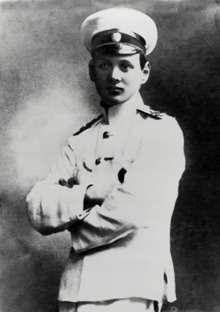Sergey Kravkov (explorer)
| Sergey Kravkov | |
|---|---|
 | |
| Born |
Sergey Nikolaievich Kravkov 23 November 1894 Saint Petersburg, Russian Empire |
| Died |
February 1942 Leningrad, USSR |
| Nationality | Russian |
| Fields | hydrography |
| Alma mater | Sea Cadet Corps (Saint Petersburg) |
| Known for | hydrographer and Arctic explorer |
| Notable awards |
Russian Empire: |
Sergey Nikolaievich Kravkov (in Russian Сергей Николаевич Кравков) was a Soviet hydrographer and Arctic explorer.
Biography
Sergey Nikolaievich Kravkov was born 23 November 1894 in Saint Petersburg in the family of a prominent Russian pharmacologist Nikolai Kravkov (1865-1924) and his wife Olga Evstafievna, née Bogdanovskaya (1868-1942), daughter of an outstanding Russian surgeon Evstafi Bogdanovsky. He spent his childhood with his parents in Germany and Austria-Hungary, after their separation in 1898 lived with his mother in Odessa.
In 1909-1914 Sergey Kravkov studied at the Sea Cadet Corps in Saint Petersburg. After the graduation he was made a midshipmen.
During World War I Sergey Kravkov served in the Black Sea Fleet. In the battle of Cape Sarych on 18 November 1914 against German battlecruiser SMS Goeben and light cruiser SMS Breslau he adjusted the artillery fire of the battleship Tri Sviatitelia. During the battle Kravkov made sketches in water color, published in the magazine “Morskoi sbornik” (# 11, 1915).
In 1917 lieutenant Kravkov completed the navigation courses in Sevastopol and got the rank of Class I Navigator. In 1918 he was transferred to Odessa Hydrographic Department. In November 1919 set out from Odessa to Vladivostok on a transportship Ierusalim. In Vladivostok he took the side of the Red Army. During Japanese intervention he went underground.
In October 1922 Sergey Kravkov was appointed Flag Officer Navigator of the Navy Headquarters of the Far East. After its reorganization in 1923 he was sent to Omsk to the Board of Security of Navigation in the Kara Sea (Ubekosibir).
In 1923-1926 Sergey Kravkov explored polar seas forming part of Ubekosibir expeditions. In 1930 he got a diploma of the deep sea navigator. In 1930-1932 he carried on hydrographic works in the Taz Estuary and the Gulf of Ob. He made sketches for the first pilot chart of the Gulf of Ob.
Since 1932 Sergey Kravkov had been specializing in astronomic works on the Northern Sea Route. His astronomical points in the Minina Skerries, Khalmyer Bay (Gydanskaya Guba) and on the East Siberian sea coast had been the basis of the maps of those areas for long.
In the intervals between navigations Sergey Kravkov taught a course of shipbuilding at the Omsk Water College. He also was in charge of a hydrometric station of the Irtysh water way.
During supervision of the delta of the Lena in winter 1940 Sergey Kravkov got his feet and hands severely frostbitten. He was sent to Tiksi settlement hospital. The doctors saved his life, but his hands and feet had to be amputated.
Being an invalid, Sergey Kravkov moved to Leningrad where his mother and sister lived. Since April to October 1941 he worked in the archives of the Hydrographic Department of the Chief Directorate of the Northern Sea Route (Glavsevmorput). Sergey Kravkov refused to be evacuated from besieged Leningrad hoping for its soon liberation. He died of denutrition together with his mother and sister in February 1942. Sergey Kravkov and his relatives were buried on the Serafimovskoye cemetery, the exact location of their grave is unknown.
Honours
Sergey Kravkov's name bears one of the biggest of the Mona Islands (the Kara Sea). This name was given to the island in 1933 by the Soviet hydrographer Vsevolod Vorobiev who first made its position measurements.
In 1974 Finland floated out a hydpographic vessel ordered by the USSR. It was named “Sergey Kravkov”. Nowadays its shipowner is the Federal State Unitary Enterprise “Gidrograficheskoye predpriyatiye” of the Ministry of Transport of the Russian Federation. “Sergey Kravkov's” port of registration is Arkhangelsk.
Awards
Russian Empire:
- Order of St. Anna 4th Class (1914)
Family
In 1920th Sergey Kravkov married a widow Antonina Aleksandrovna Charayeva. The family had three stepchildren.
See also
Selected bibliography (Russian)
- Бой 5-го ноября 1914 года у мыса Сарыч ( по рассказам участников и опубликованным данным) // Морской сборник. – 1915. – №11. – С. 1-5.
- Кравков С.Н. Определение секстантом азимута земного предмета / С.Н. Кравков // Северный морской путь: сб. статей по гидрографии и мореплаванию. – Л.: Изд-во Главсевморпути, 1937. – Т.6. – С. 11-20.
References
- (Russian) Гидрография Черноморского флота (1696-1982). Исторический очерк / под ред. Л.И. Митина. – Севостополь: Изд-во Гидрографической службы Черноморского флота, 1984. – С. 349.
- (Russian) Копытов Ю.П. Разведчики ледовых морей. О гидрографах Арктики / Ю.П. Копытов. – Архангельск: ОАО «ИПП» «Правда Севера»,2009. – С. 324-326.
- (Russian) Максимов Г.С. Гидрографические работы Сибирского гидрографического Управления в 1933 г. / Г.С. Максимов // Северный морской путь. – 1936. – №4. – С. 75-78.
- (Russian) Попов С.В. Точка на карте / С.В. Попов // Газета «Красноярский рабочий». – 1978. – 27 мая.
- (Russian) Попов С.В. Автографы на картах / С.В. Попов. – Архангельск: Северо-Западное книжное издательство, 1990. – С.100; 148; 149; 200.
- (Russian) Попов С.В. Берега мужества / С.В. Попов. – Красноярск: Красноярское книжное издательство, 1982. – 176 с.
- (Russian) Справочник по истории географических названий на побережье СССР / Изд-во министерства обороны СССР. Главное управление навигации и океанографии. – 2-е изд., испр. и доп. – 1985. – № 9012. – С. 160.
- (Russian) Узбекова Д.Г. Кравковы: два поколения ученых из Рязани / Д.Г.Узбекова – М.:Вече, 2014 – 352 с. ISBN 978-5-4444-1806-2